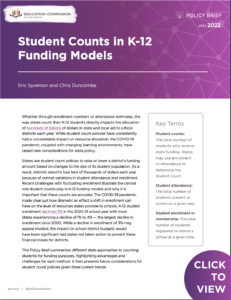States and districts allocate hundreds of billions of dollars annually to fund K-12 schools, and this allocation is largely driven by one calculation: how states count student enrollment. They do this in one of five ways:
- A single count on a single day.
- Two counts twice per year.
- Multiple counts over a period of time.
- An attendance average.
- A membership (or enrollment) average.
Each method has advantages and challenges, which are outlined in this Policy Brief.
The brief also explores important considerations for policies addressing student counts in the current context: with many students online, rather than in brick-and-mortar schools; while temporary hold harmless policies allow districts to use their prior-year numbers; and amid transitions to new measures of poverty within schools.
For information on funding models by state, see the state profiles in the 50-State Comparison on K-12 and Special Education Funding.
For more resources on funding, see our Key Issue page.



